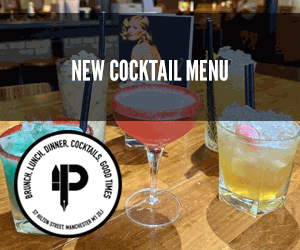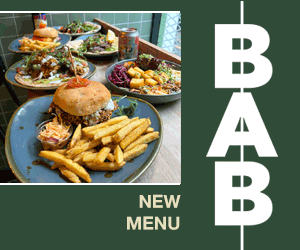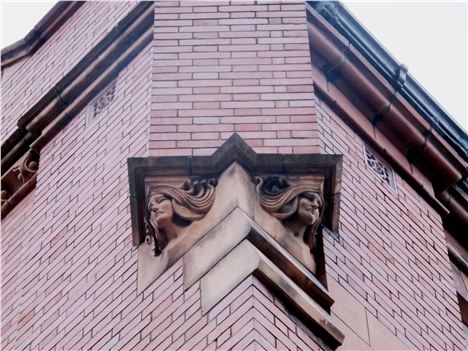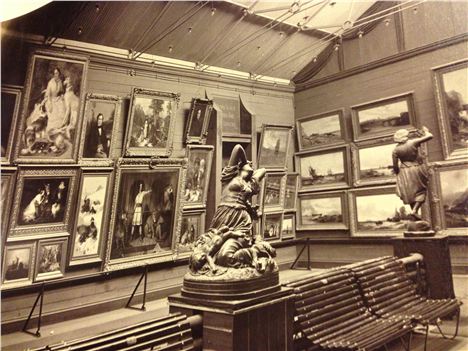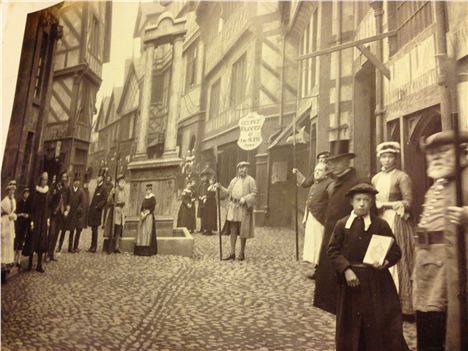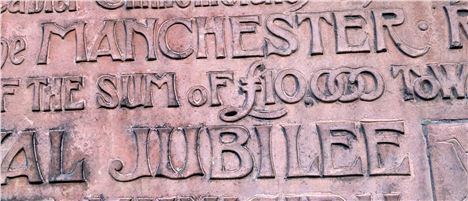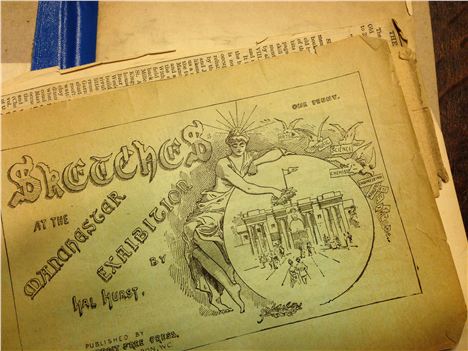Category: Glorious
What?
The Arts and Crafts typeface in the commemoration panel by WJ Neatby. You can find this on the Manchester School of Art building extension, Lower Ormond Street, Manchester Metropolitan University. All Saints in otherwords.
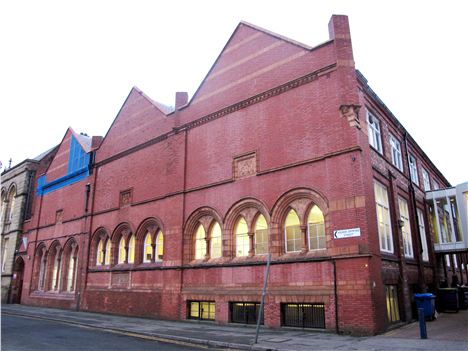 Extension to the School of Art
Extension to the School of Art
When?
Probably before 1897 when the terracotta and brick building that holds the panel with the text was erected. The building was designed by J Gibbons Sankey, who did a lot of work in Manchester including the Tootal Broadhurst and Lee Building, now Churchgate House, on Oxford Street.
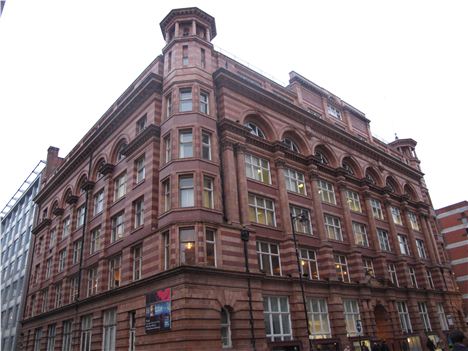 Tootal building now Churchgate House
Tootal building now Churchgate House
So who is this Neatby chap?
He was the head of the architectural department of tiling specialists Doulton – subsequently Royal Doulton. At some point he was hired by J Gibbons Sankey for the then Municipal School of Art to do the detailing on the new building. Neatby was a master of his craft and famous across the tiling world, he delivered ceramic work of exquisite finesse scarcely equalled - look at the details on the faces below of the young and older woman.
Did Neatby just work in Manchester?
No, he was internationally well-known. His work includes the famous tiles in Harrods food hall, in London. He died relatively young in 1910 at 50. I have a hunch he has unrecognised work in Manchester.
The Tootal, Broadhurst and Lee building Oxford Street - a textile warehouse, now offices - was finished the year after the extension to the Manchester School of Art. It would seem obvious to me that given his work with Neatby on the School, J Gibbons Sankey, would have continued the association for the superb terracotta work on the Tootal building. Look at the clarity of detail on the faces of the Atlantes supporting the corner of the latter building - looks like Neatby to me, although I can't find any support from textbooks on this.
What’s so special about the panel on the School of Art Extension?
Look at the execution, the beauty of the E, the care in the M, the intertwining of the Os. Look at the fit of the script in the panel and the care shown in the stylised Lancashire roses. It’s perfect. It’s carefree and yet so studied. It’s as fine an example of the Arts and Crafts movement as you can find.
Describe Arts and Crafts
Led by William Morris, arts and crafts was a British reaction that went international. It was against the monotony of mass production and industrial conformity. It was all about love of the individual object, about craftsmanship. More than any of the art movements between about 1860 and 1910 - possibly more than any art movement ever - it revered typeface. A key Arts and Crafts principle stated that every element of a design should be carefully thought through and delivered with the same skill as the more obviously significant components. Hence the breathtaking effort needed to produce Neatby’s ceramic panel here. Imagine how long it would have taken to fit that amount of text in that poetic way into the panel, every letter in the alphabet is there except k,v and z.
Arts and Crafts was also political, socialist, lefty. It wanted everybody to feel the joy of good design, all classes, all backgrounds, and that is, again, why this panel is so perfect.
How’s that?
Read it. It marks the donation of £10,000 from the profits of the Royal Manchester Jubilee Exhibition of 1887 to build the School of Art Extension building. It is a gift to future generations for their education and instruction. On the opening of the Royal Jubilee Exhibition in 1887 the Lord Mayor WH Bailey said these words: 'If when the Exhibition terminates it should be the good fortune of the Executive Committee to have a surplus, it may not be an improper thing to indulge a hope that some portion...of the profits may be used to promote technical education and that as a survival we may have a permanent Exhibition in the interests of utility and beauty'.
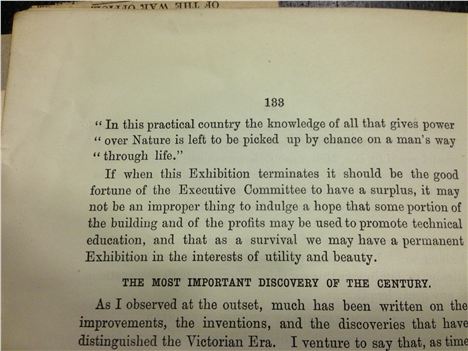 Lord Mayor's speech prior to the Royal Jubilee Exhibition
Lord Mayor's speech prior to the Royal Jubilee Exhibition
The Lord Mayor also talked about the benefits of an efficient, modern, industrial economy. He also said; 'It seems only reasonable that when human labour is economised the labourer should profit by it. Men cannot become more civilised unless they have some period of leisure in which to think in'.
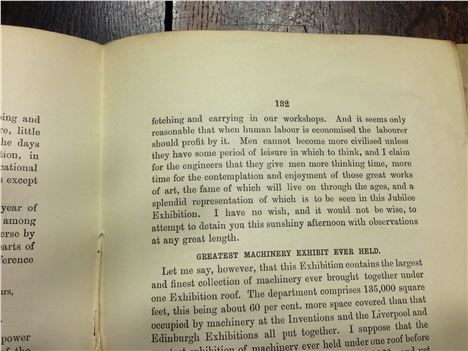 More of the speech and the need for leisure to give time for expanding the brain
More of the speech and the need for leisure to give time for expanding the brain
And they managed to carry that through?
They did. This building is one of the fruits of those ideals. It proves again that the image of nasty Victorian bigwigs at permanent loggerheads with a lumpen proletariat is simply wrong. It showed that some of them, within the constraints of their times, wanted a general progress for everybody. The sentiments in the Lord Mayor's speech are as relevant today as they were in 1887.
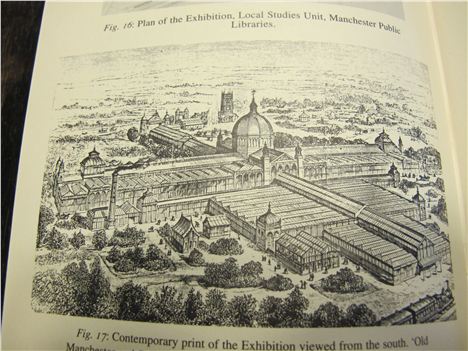 Royal Manchester Jubilee Exhibition 1887, Old Trafford
Royal Manchester Jubilee Exhibition 1887, Old Trafford
Tell me more about the Royal Jubilee Exhibition.
It was all about Manchester and region showing off its manufacturing, commercial and cultural acumen on the occasion of Queen Victoria's Golden Jubilee. It also incorporated a degree of sentimentality and one of the earliest manifestations of a 'heritage' mentality. It took up the site of the Botanical Gardens in Old Trafford and then flowed over Talbot Road to the Altrincham rail line (now the Metrolink line). It was one of the biggest exhibitions attempted anywhere up to that time, attracting more than 4m visitors in summer of 1887. It, as the press noticed, massively trumped the recent exhibitions in Liverpool and Edinburgh. Although not as significant as the Manchester Art Treasures Exhibition of 1857, the first major international art exhibition, it was still a mighty achievement.
Is there anything left of the exhibition site?
You can still see the gate to the Botanical Gardens stranded on one side of White City Retail Park. Where Pizza Hut is now there was in 1887, a re-creation of old Manchester and Salford, complete with landmarks, a replica Cathedral tower (used as a viewing platform), a replica medieval bridge, and a full size Market Place and Market Street reconstruction. Actors played the part of Mancunians from the past.
That’s the heritage point you referred to before?
Yes. Reconstructions of ‘olde times’ had happened previously in London and Paris but this was much bigger and very popular. Jorvik and all that type of thing, begins here in 1877. Of course there was a further ulterior motive.
And that was?
Manchester was fund-raising for and promoting Manchester Ship Canal. One of the exhibitions was a 35ft model of the proposed route. It was a popular attraction and provided a real boost to the crazily ambitious construction project. The first sod for the largest civil engineering scheme of nineteenth century Britain began the day after the Royal Jubilee Exhibition closed.
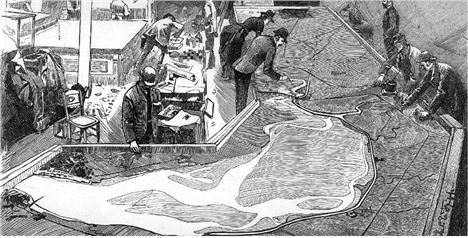 Illustration of the 35ft Ship Canal model
Illustration of the 35ft Ship Canal model
We seem to have got a long way from an Arts and Crafts panel?
History is ivy, everything is intertwined, as in rose decoration under the panel on the School of Art Extension. That lovely set of lettering links us with a gate next to Pizza Hut, looking down on Manchester Ship Canal and back to the present. It reminds us of the need for a civilised society to provide its population with an aspirational education. One last thing.
Go on
We've asked the Metropolitan University if we could reproduce the typeface as a stencil for use by other Mancunians. Of course we'd need to add k, v and z. Any designers out there with an hour or two to spare?
You can follow Jonathan Schofield on Twitter here @JonathSchofield
Thanks to all at Chetham's Library for letting us view the material relating to The Royal Jubilee Exhibition.
Out on the Tiles: Manchester, This Crazy Ceramic City
A guided tour: 1pm, Saturday 30 March, 2013
Manchester was a nineteenth century pioneer in the use of tiles, terracotta and faience, on and in buildings.
This tour takes stroll past some of the extraordinary buildings, sculptures, details and delights of this ceramic city.
We'll discuss the reason for terracotta's use in the city and some of the designers and developers who favoured this flexible material.
We'll visit buildings several buildings such as The Midland Hotel, The Refuge (Palace Hotel) and one or two real surprises (you'll have to come on the tour to find out which ones) before we finish with a viewing of the finest tiled text in the North.
As usual the commentary will be lively and entertaining.
The tour takes place on 30 March 2013 at 1pm.
Meeting point: Albert Square, outside the main entrance of the Town Hall.
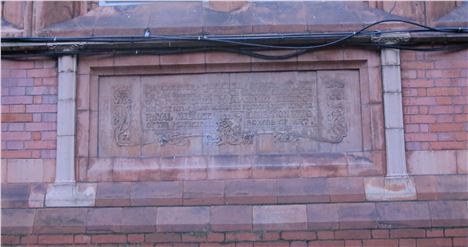 In Arts and Crafts, the ideal was everything to be produced with care - so which person put up that cabling so badly it now conceals the capitals of the terracotta columns of the panel
In Arts and Crafts, the ideal was everything to be produced with care - so which person put up that cabling so badly it now conceals the capitals of the terracotta columns of the panel
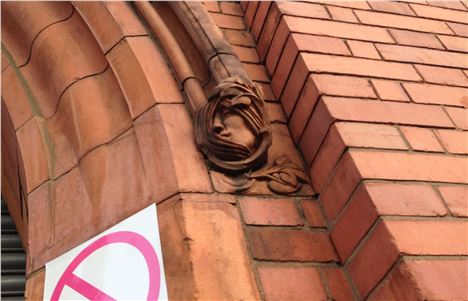 Neatby fashioned a female head on the north side of an exterior doorway and a male on on the other side. But why compromise the lovely work with a warning sign?
Neatby fashioned a female head on the north side of an exterior doorway and a male on on the other side. But why compromise the lovely work with a warning sign?
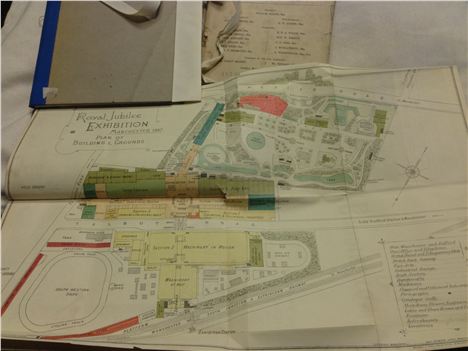 Plan of the Royal Jubilee Exhibition site
Plan of the Royal Jubilee Exhibition site
 Plan of the Royal Jubilee Exhibition site
Plan of the Royal Jubilee Exhibition site
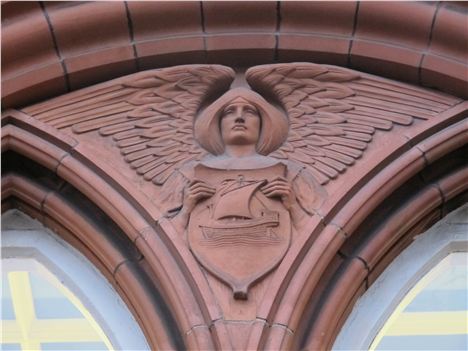 Neatby angel holding a shield with the ship from Manchester's coat of arms
Neatby angel holding a shield with the ship from Manchester's coat of arms





